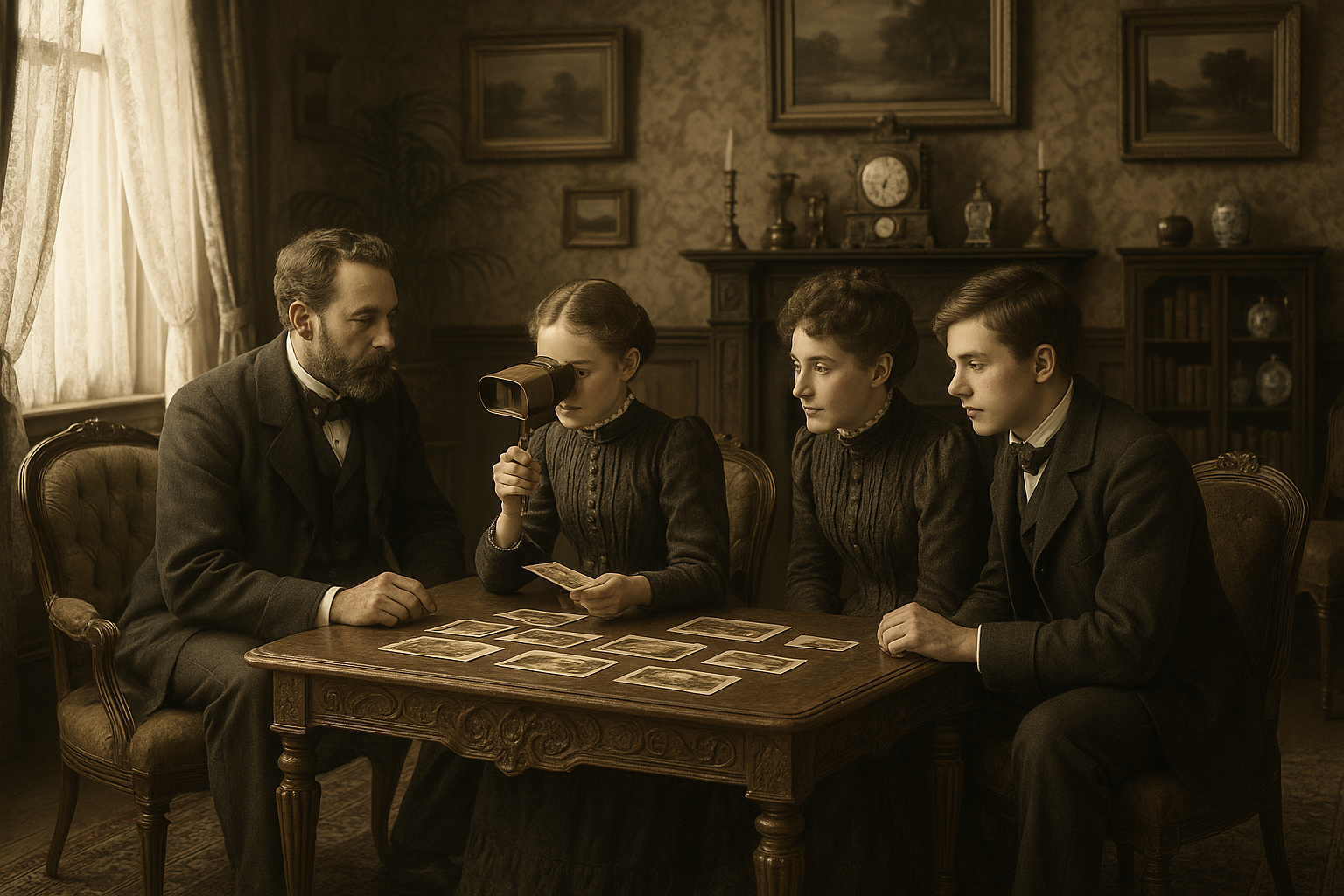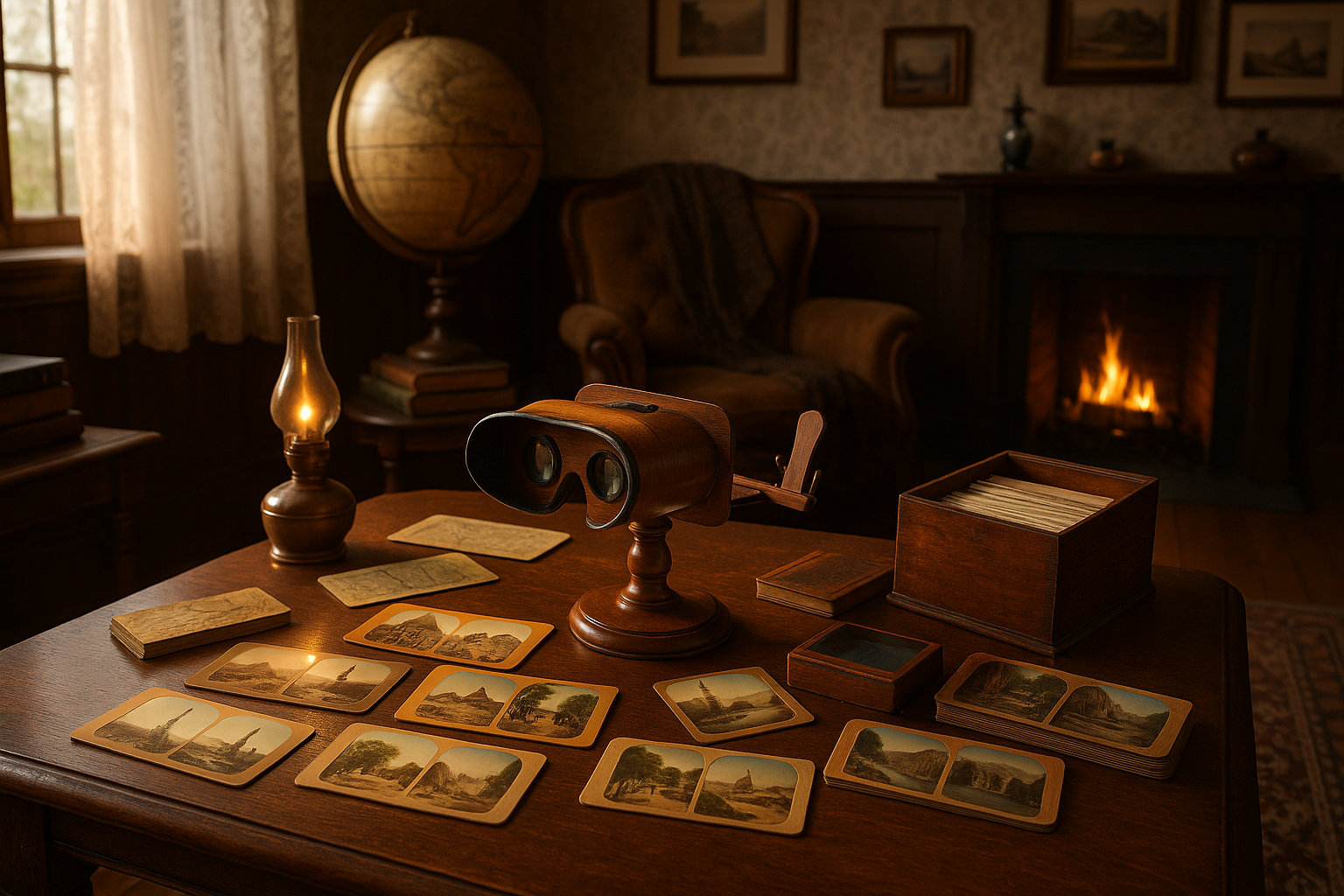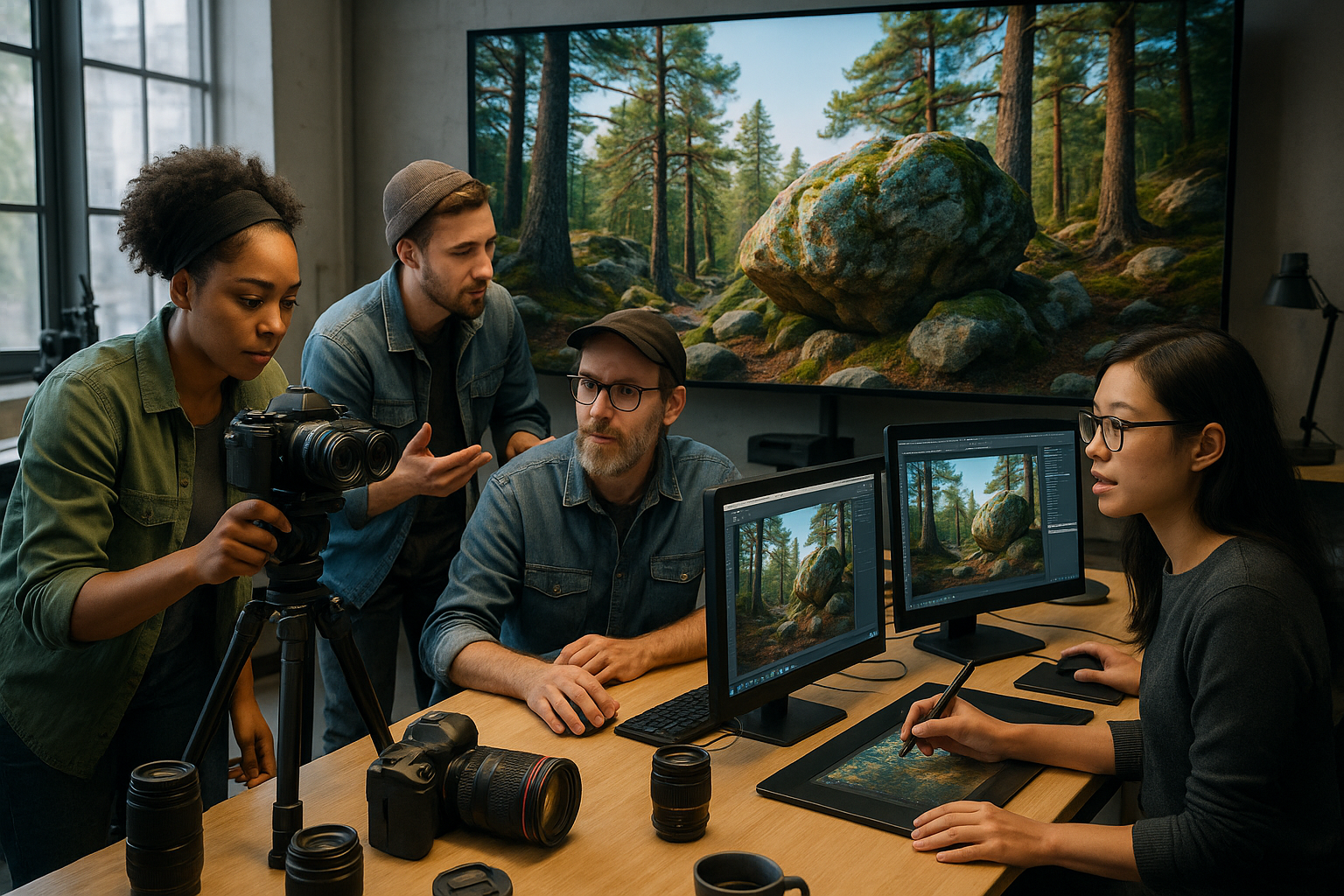Step back in time to discover how Victorian parlors transformed entertainment with stereoscopes, offering immersive 3D experiences that captivated families and sparked imaginations across the 19th century. ✨
The Magic Behind Victorian Stereoscopes: Technology Meets Art
The Victorian stereoscope represented a revolutionary leap in visual entertainment during the 1800s. These fascinating optical devices created the illusion of three-dimensional depth by presenting two slightly different images to each eye, mimicking human binocular vision. Sir Charles Wheatstone first invented the stereoscope in 1838, but it was Sir David Brewster’s compact handheld version in 1849 that truly captured the public’s imagination.
The technology was elegantly simple yet remarkably effective. Two photographs taken from slightly different angles—approximately the same distance apart as human eyes—were mounted side by side on a card. When viewed through the stereoscope’s twin lenses, the brain merged these images into a single three-dimensional scene, creating an illusion of depth that seemed almost magical to Victorian audiences.
Oliver Wendell Holmes, the American physician and poet, improved upon Brewster’s design in 1861 with an even more affordable and user-friendly version. His handheld stereoscope became the standard design, featuring a sliding mechanism to adjust focus and a hood to block peripheral light, maximizing the three-dimensional effect.
From Novelty to Necessity: Stereoscopes in Victorian Homes 🏠
By the 1860s, stereoscopes had become essential fixtures in middle-class Victorian parlors. Much like television sets would dominate living rooms a century later, these devices occupied places of honor on side tables and parlor cabinets. Families gathered around them for entertainment, education, and social bonding.
The stereoscope transformed the parlor into a portal to the world. Without leaving their comfortable homes, Victorians could virtually visit exotic locations, witness historical events, and explore distant landscapes. This democratization of travel and experience was revolutionary for an era when most people never ventured far from their birthplace.
Owning a stereoscope signified cultural sophistication and middle-class respectability. Visitors would be invited to view the family’s collection of stereocards, much as modern hosts might share vacation photos or streaming recommendations. The ritual of selecting cards, adjusting the viewer, and passing it among guests became a cherished social activity.
A Universe on Cards: The Vast World of Stereographic Content
The stereographic card industry exploded during the Victorian era, with millions of images produced annually. Major publishers like the London Stereoscopic Company boasted catalogs containing over 100,000 different views by the 1860s. Their ambitious motto proclaimed: “No home without a stereoscope.”
Popular Stereographic Subjects and Themes 📸
Stereographic content spanned an impressive range of subjects, catering to diverse interests and educational pursuits:
- Travel and Geography: Egyptian pyramids, Swiss Alps, Parisian boulevards, and American wilderness scenes transported viewers across continents.
- Historical Events: Presidential inaugurations, royal ceremonies, military parades, and disaster scenes documented significant moments.
- Architecture and Landmarks: Gothic cathedrals, ancient ruins, modern engineering marvels like bridges and railways captured technological progress.
- Natural History: Botanical specimens, geological formations, and wildlife scenes served educational purposes.
- Everyday Life: Street scenes, marketplaces, domestic interiors provided glimpses into different cultures and social classes.
- Religious Scenes: Biblical narratives, Holy Land photography, and church interiors appealed to Victorian piety.
- Comedy and Entertainment: Humorous staged scenes, theatrical performances, and whimsical narratives offered lighthearted diversion.
The Art and Science of Stereographic Photography
Creating stereographic images required specialized equipment and considerable skill. Photographers used dual-lens cameras with lenses positioned approximately 2.5 inches apart—the average distance between human eyes. This setup captured two simultaneous exposures from slightly different perspectives.
Professional stereographers became celebrities in their own right. Francis Frith, James Elliott, and the Kilburn Brothers were renowned for their technical excellence and artistic vision. They traveled extensively, often enduring harsh conditions to capture spectacular views that would enchant parlor audiences thousands of miles away.
The technical challenges were substantial. Both exposures needed identical lighting conditions, focus, and timing. Subjects had to remain perfectly still—difficult when photographing living subjects with the long exposure times required by early photographic processes. Moving elements like water, clouds, or people could create ghostly effects or spoil the three-dimensional illusion entirely.
The Staging of Victorian Stereographs 🎭
Many stereographs weren’t candid documentation but carefully staged productions. Photographers created elaborate tableaux vivants, positioning models in costumes to recreate historical events, biblical scenes, or moral narratives. These productions required theatrical skills alongside photographic expertise.
Some stereographic series told complete stories across multiple cards, functioning as early forms of sequential visual narrative—precursors to comic strips and cinema. Comic series featuring recurring characters enjoyed particular popularity, offering episodic entertainment that kept collectors purchasing new releases.
Educational Revolution: Stereoscopes in Learning and Culture
Victorian educators quickly recognized the stereoscope’s pedagogical potential. Schools incorporated stereographic sets into curricula, using them to teach geography, history, natural sciences, and art appreciation. Students could examine architectural details of ancient Rome, study geological formations, or observe foreign customs with unprecedented clarity.
Publishers produced educational sets with accompanying explanatory texts. Teachers used stereographs as visual aids during lectures, making abstract concepts tangible and memorable. This visual learning approach was innovative for an era that relied heavily on rote memorization and textbook illustration.
Museums and scientific institutions commissioned specialized stereographic documentation. Anthropologists captured indigenous peoples and disappearing cultures, creating invaluable ethnographic records (though often through problematic colonial perspectives). Archaeologists documented excavations and artifacts, preserving details that might otherwise be lost.
Social Impact: Windows to the World 🌍
The stereoscope fundamentally altered how Victorians understood the world beyond their immediate experience. For the first time in history, ordinary people could witness distant places with realistic depth and detail. This visual access to the wider world shaped attitudes, fostered curiosity, and sometimes reinforced stereotypes.
Missionary societies distributed stereographic sets depicting their work in foreign lands, generating support and donations. Travel companies used stereographs as marketing tools, inspiring wanderlust and promoting tourism. Political movements employed stereographic imagery to document social conditions and advocate for reform.
The American Civil War became one of the first conflicts extensively documented through stereographic photography. Mathew Brady and his associates created haunting battlefield images that brought the war’s brutal reality into Northern parlors, shaping public opinion and historical memory in ways that text alone never could.
The Aesthetic Experience: More Than Just Technology
Viewing stereographs offered more than mere entertainment—it provided an aesthetic experience that Victorians found deeply affecting. The illusion of three-dimensional depth created what observers described as a sense of presence or “being there” that transcended ordinary photographs.
Writers and critics praised the stereoscope’s ability to transport consciousness across space. Oliver Wendell Holmes famously described stereographs as capturing the “form” of objects while leaving behind the “matter,” creating what he termed a “card catalogue of the visual world” that could be infinitely reproduced and distributed.
The private, intimate nature of stereoscopic viewing—holding the device close, excluding peripheral vision—created an immersive experience remarkably similar to modern virtual reality. Viewers reported losing awareness of their surroundings, becoming absorbed in the three-dimensional scenes before their eyes.
Decline and Legacy: From Parlor to Museum 📜
The stereoscope’s popularity peaked during the 1860s and 1870s before gradually declining toward the century’s end. Several factors contributed to this fading enthusiasm. The novelty inevitably wore off as the technology aged. Improvements in printing allowed illustrated magazines to reproduce photographs more affordably and conveniently.
New entertainment technologies emerged to capture public attention. Magic lantern shows offered larger, shared viewing experiences. The development of cinema in the 1890s provided moving images that made static stereographs seem quaint by comparison.
However, stereoscopy never completely disappeared. The View-Master, introduced in 1939, reimagined Victorian stereoscopes for mid-20th-century audiences, particularly children. This beloved toy featured circular reels of Kodachrome transparencies, offering colorful 3D images of tourist destinations, TV shows, and cartoons across multiple generations.
Collecting Victorian Stereoscopes Today 🔍
Modern collectors prize Victorian stereoscopes and stereocards for their historical significance, aesthetic appeal, and remarkable preservation of 19th-century life. Well-preserved stereoscopes can range from affordable to quite valuable, depending on maker, condition, and rarity.
Common Holmes-pattern viewers remain relatively affordable, while elaborate parlor models with decorative woodwork command premium prices. Stereocards vary enormously in value based on subject matter, photographer, condition, and rarity. Common views sell for modest amounts, while rare or historically significant images can fetch hundreds of dollars.
| Item Type | Condition | Typical Value Range |
|---|---|---|
| Holmes Stereoscope | Good | $50-$150 |
| Brewster Stereoscope | Excellent | $200-$500 |
| Parlor Cabinet Viewer | Restored | $500-$2000+ |
| Common Stereocards | Good | $3-$15 each |
| Rare/Historical Cards | Excellent | $50-$500+ each |
Preservation and Digital Revival: Stereoscopes in the 21st Century 💻
Museums, libraries, and archives worldwide house extensive stereographic collections, many now digitized for online access. The Library of Congress, New York Public Library, and British Library offer thousands of stereographic images viewable through modern browsers, often with tools to recreate the three-dimensional effect.
Digital technology has enabled new appreciation for Victorian stereography. Enthusiasts scan stereocards at high resolution, sharing them through online communities. Special viewers and virtual reality applications recreate the stereoscopic viewing experience, allowing modern audiences to see these images as Victorians did.
Contemporary artists and photographers have rediscovered stereography as an artistic medium, creating new work that references Victorian aesthetics while exploring modern themes. The current resurgence of interest in vintage and analog technologies has brought renewed attention to these remarkable devices.
Lessons from Victorian Innovation: Parallels to Modern Virtual Reality
The Victorian stereoscope experience offers fascinating parallels to contemporary virtual reality technology. Both create immersive visual experiences that transport users beyond physical limitations. Both prompted similar societal conversations about technology’s impact on perception, experience, and reality itself.
Just as Victorians marveled at stereoscopic depth, modern users experience wonder at VR immersion. The stereoscope democratized visual travel and experience for 19th-century audiences much as digital technology democratizes information and connection today. Even the social rituals—gathering to share experiences, discussing content, building collections—echo across these technologies separated by over a century.
Understanding this historical precedent provides perspective on current technological developments. The stereoscope reminds us that immersive media, virtual experience, and screen-mediated reality aren’t entirely new phenomena but represent ongoing human desires to transcend physical limitations and access broader experiences.
Rediscovering Victorian Wonder: Why Stereoscopes Still Matter ✨
Victorian stereoscopes represent more than quaint historical curiosities. They embody human ingenuity, artistic vision, and the persistent desire to capture and share visual experience. These devices transformed entertainment, education, and cultural understanding during a pivotal era of technological and social change.
Holding a Victorian stereoscope and viewing an original card creates a tangible connection across time. The same three-dimensional illusion that captivated a Victorian family captivates us today, demonstrating how fundamental aspects of human perception and wonder remain constant despite dramatic technological advancement.
For historians, stereographs provide invaluable primary source material—windows into past landscapes, architecture, fashion, and daily life captured with realistic detail. For collectors, they offer accessible entry into photographic history with tangible objects full of aesthetic and historical richness. For all of us, they remind us that the desire to capture, preserve, and share visual experience connects past and present in profound ways.
The Victorian stereoscope’s legacy lives on in every 3D movie, virtual reality experience, and immersive media technology. Those elegant wooden and metal viewers that once graced parlor tables pioneered principles that continue shaping how we create and consume visual content. By exploring this fascinating chapter of technological history, we gain deeper appreciation for both Victorian ingenuity and our own era’s continuing evolution of immersive media.
Whether you’re a collector seeking authentic Victorian artifacts, a historian researching 19th-century visual culture, or simply someone fascinated by vintage technology, stereoscopes offer endless discovery. These remarkable devices bridged science and art, education and entertainment, capturing moments of the past in three-dimensional clarity that continues to enchant more than a century later. Step into a Victorian parlor, peer through those twin lenses, and experience the wonder that captivated an entire era—the magic of seeing the world in depth. 🎩
Toni Santos is a visual historian and artisan whose creative lens is captivated by the forgotten marvels of antique optical devices. Through his thoughtful storytelling, Toni revives the instruments that once transformed light into wonder—camera obscuras, magic lanterns, kaleidoscopes, and other ingenious tools that shaped our earliest visual imaginations.
His journey is rooted in a fascination with how humans have long sought to bend, reflect, and reveal the unseen. Whether tracing the mechanical poetry of 19th-century projectors or illustrating the tactile elegance of early lenses, Toni’s work invites us to see vision itself as an evolving art form.
Blending handcrafted design with historical inquiry, Toni brings to life the material soul of these devices—celebrating not just how they functioned, but what they meant. His creations and curated stories illuminate a world where science, illusion, and beauty were intricately linked through glass and brass.
As the curator of Vizovex, Toni shares detailed studies, reconstructed artifacts, and immersive content that help others rediscover the origins of visual technology and the magic of analog perception.
His work is a tribute to:
The craftsmanship behind early visual instruments
The wonder of seeing through the eyes of another century
The intersection of optics, art, and imagination
Whether you’re a collector, a designer, or someone drawn to the lost poetry of vision, Toni welcomes you into a world where light is a storyteller—one prism, one lens, one forgotten invention at a time.





